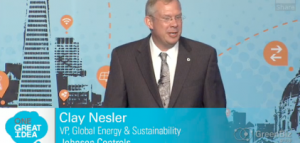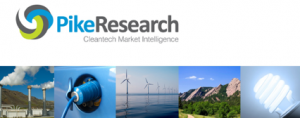 Clay summarizes the current status of the PACE program, its program benefits to the property owners, and the Prologis case study that closed in San Francisco in November, 2012.
Clay summarizes the current status of the PACE program, its program benefits to the property owners, and the Prologis case study that closed in San Francisco in November, 2012.
Johnson Control’s Clay Nesler unveils how PACE financing can help commercial property owners defer upfront costs in seeking to install energy efficiency building upgrades. Click here to see the video presentation.
In his role as vice president of Global Energy and Sustainability for Johnson Controls, Clay Nesler leads a worldwide team responsible for coordinating marketing, legislative affairs, resource management, product/service innovation and energy program management. Nesler’s responsibilities also include leading a professional services organization that develops collaborative planning tools and provides consulting services to Johnson Controls customers and third-party clients on a global basis.
Since joining Johnson Controls in 1983, he has held a variety of leadership positions in technology, new product development and marketing in both the United States and Europe. Nesler received his bachelor’s of science and master’s of science degrees in mechanical engineering from the University of Illinois at Urbana-Champaign, and is listed as a co-inventor on 10 patents.
Share this post:





 As part of Energy Upgrade California, owners of non-residential commercial properties in Los Angeles County have access to an innovative financing mechanism to fund up to 100% of the cost of building performance upgrades—Property Assessed Clean Energy (or PACE) financing.
As part of Energy Upgrade California, owners of non-residential commercial properties in Los Angeles County have access to an innovative financing mechanism to fund up to 100% of the cost of building performance upgrades—Property Assessed Clean Energy (or PACE) financing.
Investment in energy and water efficiency is an intelligent business decision. Building performance upgrades bring multiple benefits:
-
Lower operating costs
-
Improve occupants’ comfort
-
Hedge against utility price increases
-
Reduce negative exposure to possible regulation
-
Help the environment
-
Boost property values
Why PACE?
-
Funding for up to 100% of installed project costs
-
Lower financing rates than other products in the market
-
Longer financing terms than would otherwise be possible
-
Enables projects to be cash flow positive in Year 1
-
May allow for favorable accounting treatment
-
Allows for equitable sharing of costs and savings with current tenants, and future owners
For more information visit http://www.cleanfund.com/
Share this post:






Building Performance Tracking is the process of analyzing a building’s operations and energy consumption over time to identify anomalies and areas for potential improvement.
Measurement and Verification(M&V) is a process of using actual measurement, calculation, and/or modeling to reliably determine actual energy/utility savings achieved within a facility by an energy management, energy conservation, or energy efficiency project.
The PACE structure was enacted into California State law in 2008, to help property owners fund efficiency upgrades and onsite clean power generation projects. Under PACE property owners can negotiate project-specific financing terms with the investor(s) of their choice, and repay the cost of the upgrade over time through a voluntary contractual assessment on the property tax bill. PACE can be used to fund a range of building performance upgrades, from high-efficiency lighting retrofits, to advanced controls systems, to installations of fuel cells and solar photovoltaic power generation.
And because PACE assessments are fully secured through contractual assessments, capital providers have the security to offer financing at lower rates and over longer periods of time than has been possible until now. This combination of lower rates and longer terms improves the economics of deeper energy efficiency upgrades and on-site power generation projects, and allows for positive cash-flow from day one.
PACE is voluntary, not mandated by the government. It provides long term funding from private capital markets at low cost, and requires no subsidies. PACE raises property values by making buildings less expensive to light, heat, and cool and enjoys broad-based support nationwide. PACE enabling legislation has been adopted by 24 states in just 24 months, and there are dozens of programs in operation and in development around the country today.
For more information visit http://www.cleanfund.com/
Share this post:





 Despite the general weakness in new construction due to the global recession, one building-related field has continued to grow: retrofits tied to improving the efficiency of facilities. A number of factors have been driving this growth. In the new construction that has been taking place, these same drivers have been influencing the design of the buildings.
Despite the general weakness in new construction due to the global recession, one building-related field has continued to grow: retrofits tied to improving the efficiency of facilities. A number of factors have been driving this growth. In the new construction that has been taking place, these same drivers have been influencing the design of the buildings.
From Building Efficiency: Ten Trends to Watch in 2011 and Beyond
A multitude of factors will continue to influence the direction of building efficiency efforts around the world in terms of what is implemented and to what degree. Pike Research has selected ten trends among these that are certain to have a major impact on the building efficiency sector in the coming year and beyond.
Ten Building Efficiency Trends to Watch
-
Energy codes will keep raising the bar and enforcement is catching up.
-
Mandatory disclosure rules will incentivize building owners to invest in energy efficiency.
-
The pace of building certification will increase, led by LEED.
-
Building energy management systems are in high demand.
-
The U.S. ESCO market will see moderate growth and ESCOs in Asia Pacific’s developing markets will advance rapidly.
-
Lighting: Not yet “The Year of the LED”.
-
The connection between efficient buildings and the smart grid will continue to grow.
-
Increasing number of financing options around the world.
-
PACE is a financing option struggling to overcome a roadblock of its own.
-
Systemic conditions, policy choices, and practical considerations will continue to present barriers to achieving energy efficiency, but investments in training, information access, and technology will gradually overcome many of them.
Pike Research has published executive summaries for related studies:
-
Energy Efficiency Retrofits for Commercial and Public Buildings
-
Energy Efficient Buildings: Global Outlook
-
Energy Efficient HVAC Systems
-
Intelligent Lighting Controls for Commercial Buildings
-
PACE Financing for Commercial Buildings
Despite the general weakness in new construction due to the global recession, one building-related field has continued to grow: retrofits tied to improving the efficiency of facilities. A number of factors have been driving this growth. In the new construction that has been taking place, these same drivers have been influencing the design of the buildings.
Share this post:





Digital Media Strategists for SoCal electrical contractors…. dba IPLUG MEDIA
 Clay summarizes the current status of the PACE program, its program benefits to the property owners, and the Prologis case study that closed in San Francisco in November, 2012.
Clay summarizes the current status of the PACE program, its program benefits to the property owners, and the Prologis case study that closed in San Francisco in November, 2012.
 As part of Energy Upgrade California, owners of non-residential commercial properties in Los Angeles County have access to an innovative financing mechanism to fund up to 100% of the cost of building performance upgrades—Property Assessed Clean Energy (or PACE) financing.
As part of Energy Upgrade California, owners of non-residential commercial properties in Los Angeles County have access to an innovative financing mechanism to fund up to 100% of the cost of building performance upgrades—Property Assessed Clean Energy (or PACE) financing. 
 Despite the general weakness in new construction due to the global recession, one building-related field has continued to grow: retrofits tied to improving the efficiency of facilities. A number of factors have been driving this growth. In the new construction that has been taking place, these same drivers have been influencing the design of the buildings.
Despite the general weakness in new construction due to the global recession, one building-related field has continued to grow: retrofits tied to improving the efficiency of facilities. A number of factors have been driving this growth. In the new construction that has been taking place, these same drivers have been influencing the design of the buildings.